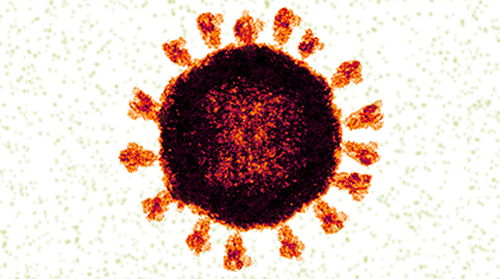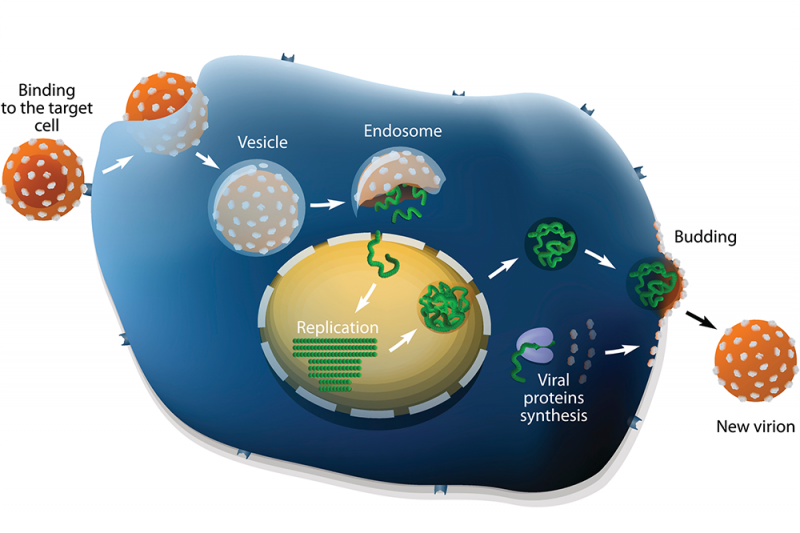
An electron microscope image of Sars-CoV-2 the virus that causes COVID-19
During the COVID-19 pandemic we’ve all probably heard more than we would like about this variant or that strain of the virus.
Viruses clearly change over time. How does this happen?
Viruses
Viruses are extremely tiny infectious agents that consist of genetic material (nucleic acid—the ‘N’ in RNA and DNA) surrounded by a protective coat of protein called a capsid.
They are the most common biological things on earth. It’s estimated that there are around 10,000,000,000,000,000,000,000,000,000,000 or ten nonillion (1031) of them. They are so small that most of them cannot be seen under an optical microscope. The SARS-CoV-2 virus that causes COVID-19 is about 1000 times thinner than a human hair. A year into the COVID-19 pandemic, in February 2021, a British mathematician estimated that all the SARS-CoV-2 virus particles in the world (about the same number as all the grains of sand in the world) would fit inside one soft drink can.
Viruses are genuinely weird. They are operate like the nanotechnology of the natural world. They’re not classified as either plant or animal. They’re generally not seen as technically alive, as they don’t move, eat, breathe, excrete, or reproduce (outside of a host cell)—many of the usual characteristics of a living thing. Some regard them as no more than parasitic fragments of RNA or DNA. The debate about whether they are a form of life, or organic structures that interact with living things is still ongoing in the scientific community.
Viruses infect all types of other life forms: humans, animals, plants, and microorganisms such as bacteria.
Viruses can’t reproduce because they can’t capture or store energy, so they need to enter and hijack the machinery of host cells and use their raw materials and energy to make copies of themselves (replicate).
Viruses vs host cells
Before a virus can enter a cell, it must attach to it. Viruses have special proteins on their outside that bind to specific receptor proteins on the host cell membrane. The spike protein on the SARS-Cov-2 virus that causes COVID-19 is one of these special proteins. In people it binds to a receptor called human ACE2 (hACE2).
Once the virus has attached, it must breach the membrane that surrounds the cell. Viruses do this in one of three ways:
- They puncture the cell membrane and connect it with their own unfolding viral envelop (capsid). In essence, they become part of the cell. This is the method used by SARS-CoV-2, HIV, and herpes simplex viruses.
- The host cell takes in the virus particle by engulfing it like a food particle (or a Trojan Horse!). Poliovirus and Hepatitis C are examples.
- Viral penetration/genetic injection. The virus attaches to the cell membrane and injects only it’s genome (genetic material) into the cell. This method is used by bacteriophages, a special type of virus.
Replication
Once the virus is in a cell, it tries to form proteins that enable it to take full control of that cell. If it can, it suppresses many of the normal functions that allow a cell to defend itself, signal, and make new proteins.
The virus can then use the host cell’s own cellular machinery and energy to make copies of itself (replication).
These processes can lead to the host cell becoming non-functional or dying, which is obviously bad for the host organism, especially when the virus is making many copies of itself and infecting other host cells.
Mutations
Errors that creep into a virus’s genetic code when it replicates are called mutations.
Most of these mutations will not benefit the virus, and some might even harm it, but a small number might be of benefit. For instance, with the SARS-CoV-2, if a mutation to the spike protein that helps the virus penetrate the cell makes it more effective at doing that, this mutation may give that variant of virus an advantage.
Some viruses, such as measles, don’t change much over time. This means once you are vaccinated against it, or you’ve had measles, your immunity may last a long time.
Other viruses, such as flu, mutate much more rapidly. if you have been infected with flu, you can be infected again when your immunity wanes or that flu mutates, and your body doesn’t recognise it.
Each year the World Health Organisation studies what the dominant strains of flu are, and flu vaccines used in Australia usually include the top three strains (top four for older people).
Because of the very large number of cases of COVID-19 across the world, the virus replicates a huge number of times and the likelihood of mutations greatly increases.
Variants and strains
Viruses with mutations in their genetic code are called variants. Variant refers to the differences in the genetic code from that of the original virus, but strain refers to a different physical property or behaviour exhibited by the virus. It can be confusing, but it may help to remember that all strains are variants, but not all variants are strains!
